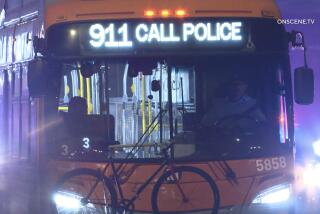MTA Unveils New Buses, but Foes Are Unimpressed
Saying they “got the message” about the need to improve their aged bus fleet, managers of the Metropolitan Transportation Authority sought to upstage their critics Monday, showing off part of their fleet of new buses and boasting about improvements in service.
But, try as they might, MTA administrators found it hard to shake the difficult if not monumental problems they face in meeting a court order to improve service and overcome problems that have plagued them for years, such as graffiti-scarred buses, breakdowns and inadequate fleet size.
The gleaming new $400,000 buses--with security video camera systems, improved access for the disabled and elderly, bike racks and engines that burn clean fuel--seemed only to call attention to past problems.
The message presented Monday: Customer complaints were down 25% between August 1998 and August 1999, the miles between mechanical failures improved 29% over the same period, and the number of canceled bus runs dropped by 931.
“We got the message. We really got the message,” said Julian Burke, the MTA’s chief executive officer, standing in a bus yard on the Eastside. He was surrounded by 40 new buses, some adorned with MTA’s new advertising slogan: “It’s getting better on the bus.”
Burke reminded critics that he acknowledged months ago that “the Metro bus system is broken.”
“We have committed to fix it, and it is being fixed,” he said.
But, despite the festive display of new buses and attitude, much of the data that the MTA was offering was gathered under a special court order in compliance with a consent decree requiring the transit agency to take remedial actions to improve service.
So far, 712 new buses have been acquired, with 663 on order, but the MTA concedes that the new buses will replace the older, worn-out buses that were at the heart of legal actions taken against the transit operator in an effort to force improved service.
Critics, reacting to Monday’s news media event, said MTA was taking a small step to meet a big need--one that didn’t justify Monday’s hoopla.
They noted that MTA continues to vigorously fight the Bus Riders Union and the NAACP Legal Defense and Educational Fund in court to block efforts that would force the transit agency to expand its bus fleet beyond the steps it is willing to take. Just over a week ago, Chief U.S. District Judge Terry J. Hatter Jr. refused to grant a stay of this order requiring the MTA to acquire 248 temporary buses to relieve overcrowding and improve service.
“There is no question they are making progress,” said Eric Mann, a member of the leadership committee of the Bus Riders Union. “What they don’t understand is they are not making progress nearly as fast as the court order requires, as the consent decree requires and as bus riders require.”
One of the statistics that the MTA sought to publicize was that their surveys showed that they were in 99% compliance of the order to reduce overcrowding.
Leaders of the Bus Riders Union, which sued MTA in September 1994 to force it to relieve overcrowding and fix its dilapidated fleet, bristled at what they said was MTA’s continued use of a statistical method of measuring overcrowding that the court has refused to accept.
“It is a meaningless claim of compliance,” said union organizer Ted Robertson. “We still know there is an enormous amount of overcrowding on the buses.”
Attorney Richard Larson of the NAACP Legal Defense and Educational Fund said the buses put on display Monday were ordered 18 months ago and would replace buses that are 18 or 19 years old. He said the normal life span of a bus is about 12 years.
What’s more, Larson said, “none of this has anything to do with expansion of the size of the bus fleet in order to reduce overcrowding.”
Like Mann, Larson said he appreciated MTA’s efforts to improve, but added, “They are continuing to fight us every mile, every inch, with regard to expanding the bus fleet.”
At the news conference, Los Angeles County Supervisor Yvonne Brathwaite Burke, chairwoman of the MTA board, acknowledged the critics.
“There is a lot of room for improvement. We know that,” she said. “We are moving, we are improving. We may have a long way to go, but 44% of MTA’s budget [$931 million] is being spent on buses.”
The new buses are outfitted with video cameras that will record inside and outside the buses. The cameras, similar to those in convenience stores, are intended largely to catch riders who deface bus windows or paint graffiti on walls and seats.
Officers from the Los Angeles Police and Los Angeles County Sheriff’s departments said crimes other than vandalism are minimal compared to the crimes occurring in the neighborhoods the bus system serves.
Serious crime aboard buses “is almost nonexistent,” Sheriff’s Capt. Marc Klugman said.
More to Read
Sign up for Essential California
The most important California stories and recommendations in your inbox every morning.
You may occasionally receive promotional content from the Los Angeles Times.









